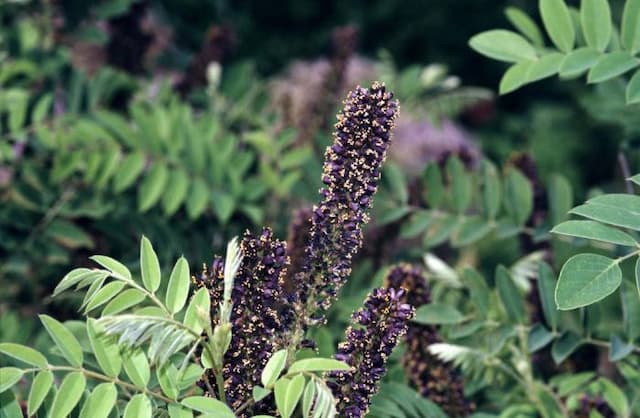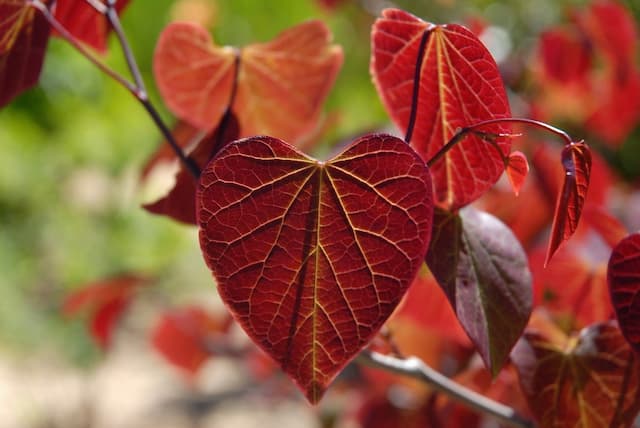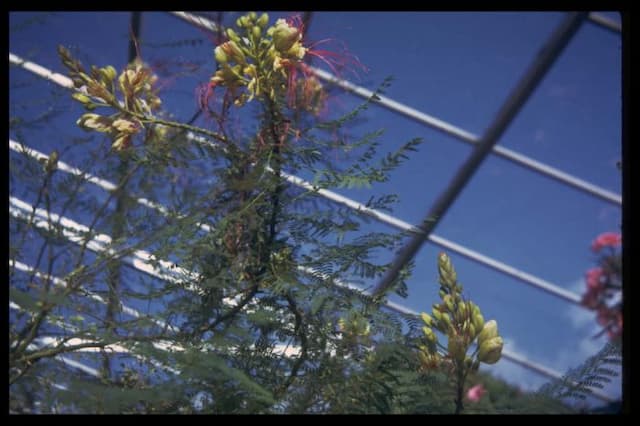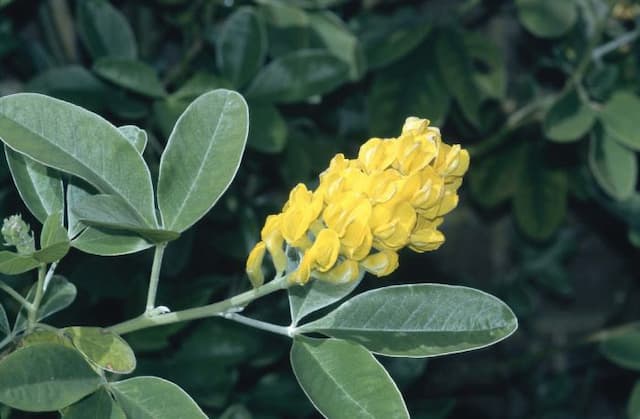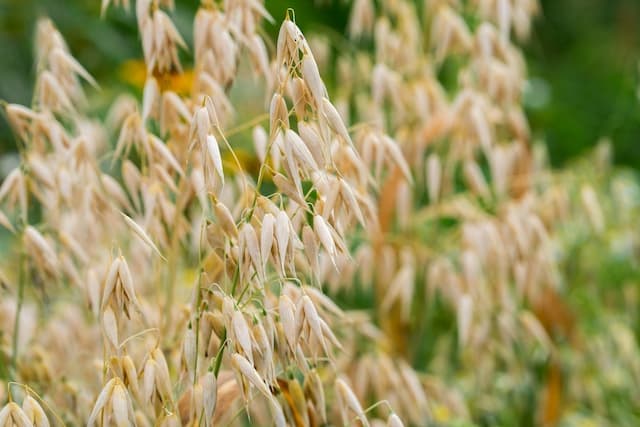Hyacinth Bean Lablab purpureus

ABOUT
Lablab purpureus, commonly known as hyacinth bean, is a climbing plant characterized by its twining stems that allow it to grow upwards by spiraling around supports. The foliage is comprised of large, bright-green, trifoliate leaves, which means each leaf has three leaflets. The plant is well-known for its striking purple flowers that grow in showy, upright racemes, resembling sweet pea blossoms. These clusters of flowers add an ornamental appeal to the plant, making it a favorite in gardens. As the flowers fade, long, flat, purple seed pods develop, which are sometimes referred to as beans. These pods hang off the vine and contain seeds within them. The contrast between the green leaves and the purple flowers and pods is visually striking, creating a vibrant display. The hyacinth bean's growth habit, foliage, and flowers together contribute to its popular use in ornamental gardens and landscaping projects where it can climb on arbors, fences, or trellises, notwithstanding its other uses in different cultures.
About this plant
 Names
NamesFamily
Fabaceae.
Synonyms
Hyacinth Bean, Dolichos Bean, Seim Bean, Lablab Bean, Egyptian Kidney Bean, Indian Bean, Australian Pea, Bonavist Bean, Bataw.
Common names
Dolichos lablab, Dolichos purpureus, Lablab niger, Lablab vulgaris, Vigna aristata.
 Toxicity
ToxicityTo humans
The hyacinth bean (Lablab purpureus) contains cyanogenic glycosides, which can release cyanide when ingested. It is important to note that the beans should not be eaten raw, as this can lead to poisoning. Symptoms of hyacinth bean poisoning may include nausea, vomiting, diarrhea, abdominal pain, dizziness, weakness, and in severe cases, respiratory failure, and even death.
To pets
Similar to humans, hyacinth bean (Lablab purpureus) is also toxic to pets due to the presence of cyanogenic glycosides. If a pet ingests raw beans or other parts of the plant, symptoms may include vomiting, diarrhea, abdominal pain, and weakness. Severe poisoning can lead to difficulty breathing, seizures, and potentially be life-threatening. Owners should ensure their pets do not have access to hyacinth beans, especially in their raw form.
 Characteristics
CharacteristicsLife cycle
Perennials
Foliage type
Deciduous
Color of leaves
Green
Flower color
Varies
Height
10 feet (3 meters)
Spread
3 feet (0.91 meters)
Plant type
Climber
Hardiness zones
10
Native area
Africa
Benefits
 General Benefits
General Benefits- Nutritional Value: Lablab purpureus, also known as hyacinth bean, is high in proteins, vitamins, and minerals, which contribute to a balanced diet.
- Nitrogen Fixation: Hyacinth bean improves soil fertility by fixing atmospheric nitrogen, benefiting other plants grown in the same area.
- Food Source: The beans, leaves, and tubers are edible and can be used in a variety of dishes, thereby contributing to food security.
- Fodder: The plant can be used as animal feed, providing valuable nutrition for livestock.
- Drought Resistance: Hyacinth bean is relatively drought-resistant, making it a dependable crop in arid regions.
- Cultivation Ease: It is easy to grow and requires minimal care, making it accessible for small-scale farmers and gardeners.
- Erosion Control: The plant's dense foliage and root system can help prevent soil erosion, particularly on slopes.
- Ornamental Value: With its attractive flowers, it is often used as an ornamental plant, enhancing the aesthetics of gardens and landscapes.
- Shade Provider: The vine can create natural shading when grown on trellises or fences, offering cool areas in gardens or farms.
- Intercropping: Hyacinth bean can be used in intercropping systems to enhance productivity and sustainability of farming practices.
 Medical Properties
Medical Properties- Antioxidant Activity: Lablab purpureus has been shown to contain compounds with antioxidant properties that may help in scavenging free radicals in the body.
- Anti-diabetic Effect: Some studies suggest that the plant might have potential in managing blood sugar levels, possibly due to its fiber and protein content or other bioactive compounds.
- Anti-inflammatory Properties: Components within Lablab purpureus may have the ability to reduce inflammation, useful in treating various inflammatory conditions.
- Gastrointestinal Health: The plant's seeds are believed to aid digestion and have been traditionally used to treat issues such as diarrhea and stomach pain.
 Air-purifying Qualities
Air-purifying QualitiesThis plant is not specifically known for air purifying qualities.
 Other Uses
Other Uses- Lablab purpureus, commonly known as hyacinth bean, can be used as a livestock feed. The beans and foliage can be used as forage for animals, although they should be fed in moderation due to potential toxicity.
- The vine of the hyacinth bean can serve as a natural screen or living curtain when grown on trellises, providing privacy and shade in garden spaces.
- In some cultures, the dried beans are used as musical instrument fillers, especially in maracas, to create a rattling sound.
- The sturdy vines and attractive flowers of the hyacinth bean can also be used as ornamental decoration in floral arrangements and bouquets.
- The hyacinth bean plant's broad leaves can sometimes be employed in crafting, serving as natural biodegradable wrappers for small items or food.
- Its rapid growth and dense foliage make the hyacinth bean an excellent choice for creating temporary green structures or for concealment in tactical situations such as wildlife photography blinds.
- The dried stalks of mature hyacinth bean plants can be repurposed as plant stakes or natural support for other climbers in the garden.
- In some tropical areas, hyacinth bean pods are used as floats for fishing nets due to their buoyancy when dried properly.
- The plant's strong root system is beneficial for soil stabilization, helping to prevent soil erosion on slopes and banks.
- Hyacinth bean is occasionally used in permaculture gardens as a nitrogen-fixer to improve soil fertility, enhancing the growth condition for subsequent plants.
Interesting Facts
 Feng Shui
Feng ShuiThe Hyacinth bean is not used in Feng Shui practice.
 Zodiac Sign Compitability
Zodiac Sign CompitabilityThe Hyacinth bean is not used in astrology practice.
 Plant Symbolism
Plant Symbolism- Love and Tenderness: The heart-shaped leaves of the Hyacinth Bean plant symbolize love and the emotional connection one has with others, reflecting the tenderness of intimate relationships.
- Nourishment and Growth: As the Hyacinth Bean is a legume that enriches the soil where it grows, it symbolizes the idea of feeding the body and soul and supporting the growth of oneself and others.
- Unity: The twining growth habit of the Hyacinth Bean, often growing together with other plants, can represent unity and interconnectedness within communities.
- Prosperity: The prolific growth and abundant seed production of the Hyacinth Bean can be seen as a symbol of prosperity and the potential for abundance in one's life.
- Beauty: With its attractive purple flowers and pods, the Hyacinth Bean stands for the appreciation of beauty in the natural world and the aesthetics that bring joy and happiness.
 Water
WaterThe hyacinth bean (Lablab purpureus) should be watered deeply, ensuring that water reaches deep into the root zone. Typically, this means providing it with approximately 1 inch of water per week, whether through rainfall or manual watering. During hot, dry periods, watering frequency should be increased to every few days to maintain soil moisture, without causing waterlogging. It's best to water the plant early in the morning, which allows leaves to dry out during the day and reduces the risk of fungal diseases. Monitor the plant to ensure it receives enough water for steady, vigorous growth without becoming overwatered.
 Light
LightThe hyacinth bean prefers full sun conditions and thrives best when provided with at least six hours of direct sunlight per day. The ideal spot for this vigorous vine is a location where it can receive unfiltered, direct sunlight for most of the day, which encourages maximum flowering and pod production. Light shade is tolerated, but the amount of blooms and growth may be reduced.
 Temperature
TemperatureFor the hyacinth bean, an ideal temperature range is between 60°F and 90°F. The plant can handle temperatures as low as 50°F but should be protected from frost, which can damage or kill it. During the growing season, maintain as consistent a temperature as possible within this range to promote healthy growth.
 Pruning
PruningPrune hyacinth beans to maintain their shape and encourage bushier growth. The best time for pruning is early spring, before new growth begins. Pruning can be done several times throughout the growing season to remove dead or damaged vines and control the size of the plant. Regular pruning also stimulates new growth and can lead to more flowers.
 Cleaning
CleaningAs needed
 Soil
SoilHyacinth bean thrives in a soil mix consisting of well-draining loam or sandy-loam with rich organic matter. The ideal soil pH should be between 6.0 and 7.5, ensuring that it's slightly acidic to neutral. A mix incorporating compost or aged manure can optimize growth and pod production.
 Repotting
RepottingHyacinth bean plants, typically grown as annuals, do not usually require repotting. When grown in containers, they may be planted at the start of the growing season and will likely not need repotting before the end of their annual life cycle.
 Humidity & Misting
Humidity & MistingHyacinth bean plants are relatively tolerant of various humidity levels, but they prefer conditions that simulate their native tropical climate. As such, maintaining moderate to high humidity is ideal for optimal growth.
 Suitable locations
Suitable locationsIndoor
Place in bright light, warm area, ensure pot has drainage.
Outdoor
Full sun, rich soil, water regularly, support for climbing.
Hardiness zone
10-11 USDA
 Life cycle
Life cycleLablab purpureus, commonly known as hyacinth bean, begins its life cycle as a seed that germinates in warm, moist soil. Seedlings emerge in the spring and grow quickly, developing a climbing or trailing vine with trifoliate leaves. The plant produces fragrant purple, pink, or white flowers throughout the summer, which are followed by the development of elongated, flat pods containing seeds. These pods eventually dry and release their seeds, which can lie dormant in the soil until the next growing season. Hyacinth beans are perennial in warm climates but grown as annuals in cooler regions, where they die back with the first frost. The cycle is then repeated the following season when new seeds germinate.
 Propogation
PropogationPropogation time
Spring-Early Summer
Propogation: The most popular method of propagation for hyacinth bean (Lablab purpureus) is through seeds. To ensure successful germination, the seeds should be sown in the spring after the last frost when the soil has warmed up, typically at a temperature of 65-75°F (18-24°C). The seeds benefit from being soaked in water overnight prior to planting to soften their hard coats and encourage sprouting. Sow them at a depth of about 1 inch (2.54 centimeters) and space them 4-6 inches (10-15 centimeters) apart in well-draining soil with full sun exposure. Seedlings usually emerge within 10-14 days. It's important to keep the soil moderately moist during the germination period. Once established, the hyacinth bean will grow vigorously, often requiring a trellis or support to climb.
